In the beginning...
My first impression of the Modelltrans was one of disappointment. When it arrived the cab component was broken and the broken parts were missing, this complicated what I was hoping would be a fairly straight-forward conversion.
Left: How the MT V3000 conversion kit was supposed to have been delivered to me. It wasn't, mine came in just a small plastic bag - no labelling - and was broken to boot.
The next disappointment was that I couldn't accurately identify exactly which version of the Ford V3000 this model was supposed to be. My MT V3000 came without the package label, which points out that this is supposed to be a 'Ford V3000 early'. This - as it turned out - was an important omission.
(This is likely NOT ModellTran's fault - I get the feeling that my example was on the back of someone's shelf and I was the unlucky sucker who got the short end of the stick! As it was from Eastern Europe I wasn't going to send it back.)
 |
| First job, repair the broken MT cab. A frustrating start... |
I easily located the cheap Italeri Opel Blitz (kit #7014) needed to complete this conversion on eBay. It isn't the best Opel Blitz model out there, but it's not the worst either - the chassis is particularly nice and fairly well detailed. However, two parts that you need for this conversion that aren't so well done are the canvas tilt, which lacks detail or character, and the wheels, which have some noticeable mould impressions in them.
The conversion process is pretty straight forward in theory, the MT kit only has two main parts (and some minor ones). These are the MT V3000 cab which consists of the cab exterior and a cab floor and seating. Sadly there were not instructions - I guess MT thought its should be so obvious that it didn't need directions - but the mating of the MT cab to the Italeri chassis was not as easy as expected and needed some amount of tinkering to achieve a secure fit...
 |
| You have to work out how best to mount the MT cab sections on the Italeri chassis yourself. I constructed a platform and frame solution. |
One step forward, one step back
Compounding my mistake - by lowering the front suspension - I began 'improving' the fenders to make them more like the 'early' V3000's deeply rounded mudguards...
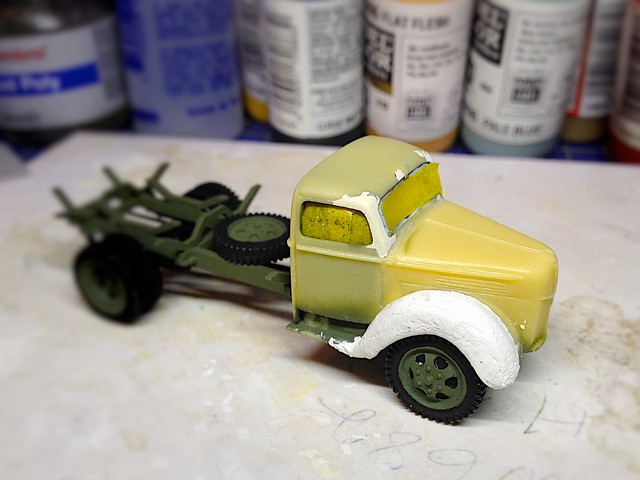 |
| Wrong, wrong, wrong! (...Wrong!) |
But there was still one thing wrong - having lowered the cab it now sat too low for the German 'late' version (this is what you get for trying to be 'clever')!
Note: If I wanted the *accurately* modelled 'early' fenders you would have to modify them with modelling putty like I had started to (above) OR if you want an accurate set of 'late' fenders you will have to thin and straighten out the MT mudguards as per this reference photo...
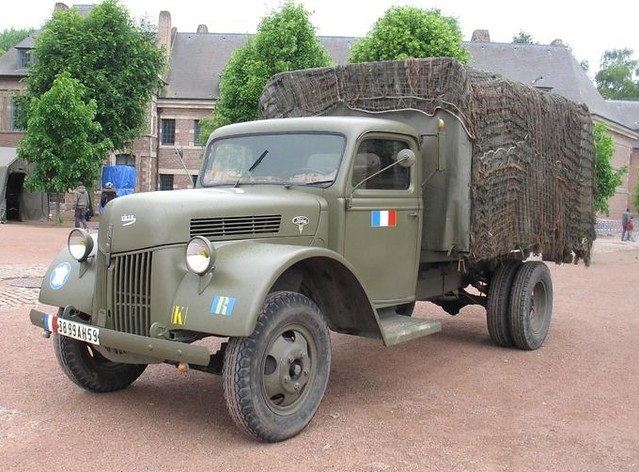 |
| This reference photo shows a late model European V3000 with the simplified (flat) front fenders and the high sitting suspension. Photo source: Maquette Garden |
In conclusion
As you can tell, I made a hash of what - really - should have been an fairly easy conversion. Yes I wasn't helped by the lack of instructions or labelling - which had me barking up the wrong tree - but if I had done a bit more research online about what the MT kit was I would have saved myself a lot of time.
My foolishness aside I am actually quite pleased with the outcome, and did enjoy making and painting the kit. It is a nice option if you really want to add a German V3000 to your collection - just don't fall for MT's assertion that it is a 'early' version of the truck (which had deeply rounded fenders), it isn't. This is what a real early version looked like...
 |
| An example of an 'early' V3000 with it's deeply 'rounded' fenders. Photo source: 9thsspanzer.com |
• Lack of thought-out design to secure the MT cab section to the Italeri chassis
• Ambiguous MT fender designs - which look neither 'early' or 'late'
• Badly moulded Italeri wheels
• The Italeri front-bumper is OK (but still not quite right) if you are doing an 'early' V3000 but isn't the right shape at all for the 'late' model (but I ignored that and used it anyway).
But as long as you are aware of these issues a good job can still be made of the conversion.
On the positive side, the ModellTrans conversion is a quick and easy way of you getting a Ford V3000 into your collection. Currently there is no V3000 plastic kit available in 1/72 (though there are lots in 1/35) and this is a real shame as it seems that 1/72 kit manufacturers are restricting Braille Scale modellers to the idea that the only WW2 German truck was the Opel Blitz!
The Ford V3000 was a very interesting and important truck. Not only was it a numerically popular design it was one of the few vehicles that was being simultaneously manufactured by both the Axis and Allied sides during the early-mid half of the war! You were just as likely to see a V3000 being rode into action in the Western Desert by either the British 8th Army as you were the Africa Korps! It was used - Lend Lease - by the Soviets while the Dutch and Australians used it in the far east where captured examples were subsequently used by the Japanese!
So, if you want to feature the V3000 - in whatever army you are interested in - the ModellTrans/Italeri conversion kit is the easiest and cheapest way to do this.
Left: Hunor have a V3000 short-run resin kit available but this is about $29 plus shipping. This is a accurately modelled 'Late' German version. Still, that's your only kit alternative, but you have to search hard for it.
All in all, I am very happy with the ModellTrans V3000 conversion kit - despite my meandering diversions! At just €5.91 (plus shipping, plus the cost of the Italeri Opel Blitz) it's a reasonably priced modelling adventure.
All that's left for me to do now is to take those all important completion photos. Teaser below...
Related/useful Links:
• ModellTrans Modellbleu offcial website
• ModellTrans catalogue at Henk of Holland review site
• Conversion kit available from: 'Tank Models' store, Poland.
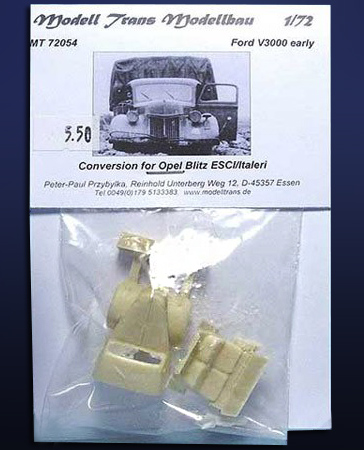

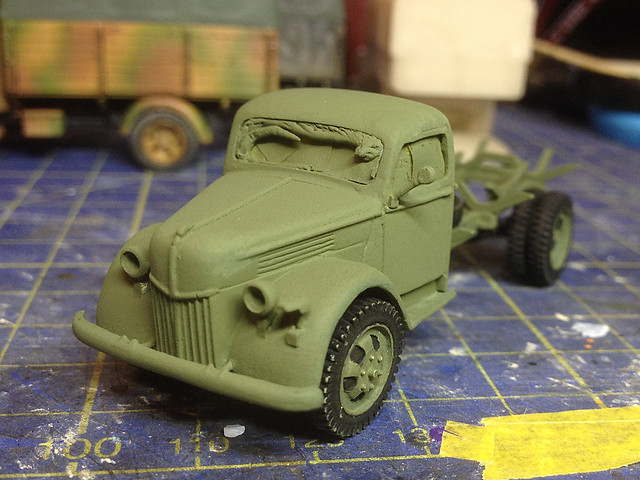


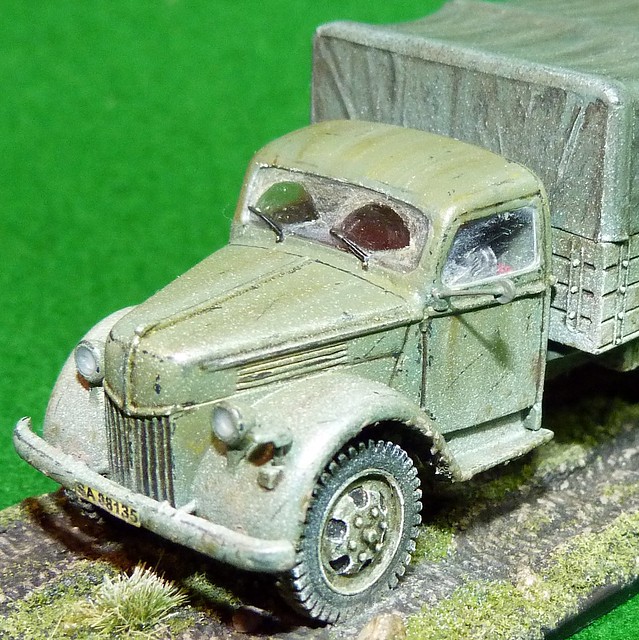
I agree with everything you say about the conversion kit. It is disappointing - neither an accurate depiction of an early or late V3000. It's also disappointing that they don't include an accurate set of wheels. I have never seen a photo of a wartime V3000 with anything other than five slots in the wheels and the Blitz has six. It is still better than the PST Ford 6 though, which is a complete aberration. The artist who drew it for the instruction leaflet has even changed his drawing of the real vehicle to look like the innacuarate parts (such as the cab) in the kit.
ReplyDeleteYou have done an admirable job with your conversion, despite the frustrations along the way.
It's a really strange situation - I've tried to think why they would produce the design of cab that they have. It is really confusing for beginners like myself - expert modellers who have done their research will spot the problems right away.
DeleteAs I say - I am very happy with how the conversion goes together now I have clarified why it looks the way it does, but even so it's still not 'the perfect V3000' in 1/72!
Beautiful work ! i added your blog in my list.
ReplyDeleteBeautiful work !
ReplyDeleteI added you in my blog list.